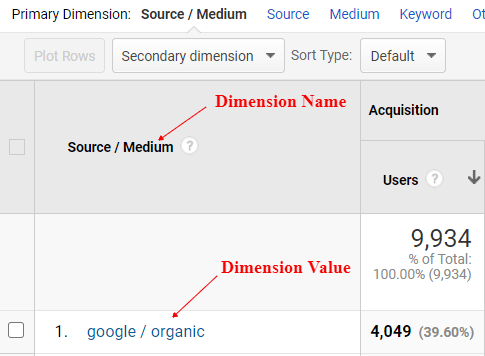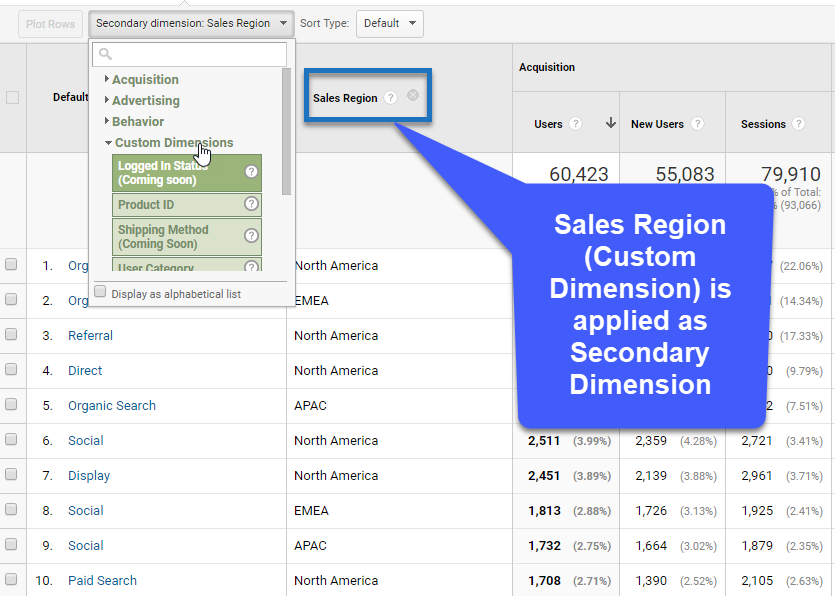Not known Facts About What Is A Secondary Dimension In Google Analytics
Wiki Article
What Is A Secondary Dimension In Google Analytics - Truths
Table of ContentsThe Single Strategy To Use For What Is A Secondary Dimension In Google AnalyticsNot known Facts About What Is A Secondary Dimension In Google AnalyticsWhat Does What Is A Secondary Dimension In Google Analytics Do?What Does What Is A Secondary Dimension In Google Analytics Do?
Or if you have a brick-and-mortar company, you may wish to track foot traffic by store place. Age: This measurement can offer insights into which age groups are most curious about your service or product. Sex: Sex can impact purchasing choices as well as brand loyalty, so it's often worth tracking individually from various other demographic information like age as well as location.The main dimension in Google Analytics is the primary group that you are assessing, such as page views, sessions, or individuals. With additional measurements, you can include an additional layer of data to your evaluation, providing you a lot more context as well as understanding of your web site's performance. In this section, we will explore why additional measurements are important and also offer an example of just how they can be made use of
One of the most considerable benefits of using additional measurements is that they assist you to determine which pages or products are prominent in various areas. This is specifically beneficial for services that run in several regions or nations, as it can help them to customize their advertising and marketing initiatives to those particular areas.

If you discover on your own in this circumstance, there are a few things you can do to raise the amount of data in your record. Initially, consider raising the date series of your report. By default, Google Analytics will just reveal data for the past month, but you can alter this to reveal information for approximately the previous year
What Is A Secondary Dimension In Google Analytics Can Be Fun For Everyone
A statistics is an item of information that can be gauged and also used to track development or goal success. In Google Analytics, metrics are utilized to track web site traffic and activity.The "Bounce Rate" is the percent of visitors to a site who leave the website after checking out just one page. A high bounce price may indicate that a site's content is not relevant to the site visitor's demands. When it involves Google Analytics, measurements are among the most vital pieces of data that you can track.
A dimension is an item of details that can be made use of to describe a specific facet of your internet site or application usage. Some usual measurements may consist of: Pageviews: The number of times a page on your website was checked out.
Place: Where on the planet your users are found? There are literally hundreds of measurements that you can track in Google Analytics, and new ones are being included regularly. The finest method to discover all the different dimensions available is to discover the Google Analytics documentation or explore tracking various types of data on your own site or application.
The Best Guide To What Is A Secondary Dimension In Google Analytics
Among the important things it tracks is the kinds of hits that are being made on the site. There are four different kinds of hits that Google Analytics tracks: site pageviews, one-of-a-kind pageviews, events, and also purchases. Pageviews are the most standard metric as well as just count exactly how lots of times a page on your site has actually been filled.Occasions are user communications with specific elements on your web page, such as clicks or video plays. You can use this data to see what individuals are interested in on your site and also make changes as necessary.

As nearly any individual who runs a website knows, Google Analytics provides insight right into that website visitors are and also what they do when they involve a web site - What Is click to find out more A Secondary Dimension In Google Analytics. Online marketers utilize Google Analytics to understand the results of advertising projects and exactly how a site's individual experience effects aspects such as conversion as well as retention
What web pages do they check out? How much time do they remain? You can examine these metrics to understand the overall individual experience and its results on retention and also interaction. tracks whether consumers act that you desire them to take. This typically entails specifying funnels for vital activities such as purchases to see how well the website encourages these activities in time.
Not known Factual Statements About What Is A Secondary Dimension In Google Analytics
Dimensions are categorical characteristics, such as the city where a customer lies or the web browser they make use of, while metrics are the quantitative dimensions, such as number of sessions or pages per session. According to Google, "Not every metric can be integrated with every measurement. Each dimension and metric has a range: user-level, session-level, or hit-level.Average pages per session is the variety of web pages an individual sights, generally, in a single session on your site. You can locate this in the dropdown in the Overview section under Target market, or if you're accessing the metric with the API, use ga: pageviews, Per, Session. The number of pages with which a user connects is another good proxy for user involvement.
If your bounce price is high, you need to section your site visitors to see if you can identify the underlying problem. At the base of the Summary web page, you can choose Browser to identify if the website performs better or even worse for visitors using various web browsers: Organic search web traffic is traffic from users who came from a non-paid search engine results web page (SERP).
The following guidelines will certainly stroll you via the procedure: Produce a brand-new Google Spread sheet (or open up an existing one). From the menu bar choose: their explanation Attachments > Obtain Add-ons Find the Google Analytics Attachment from the attachments gallery as well as choose it. From the add-on summary page, click the "+" in the leading right corner to add this add-on to your spread sheet.
Report this wiki page